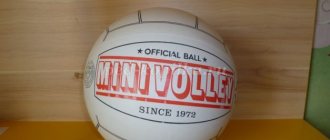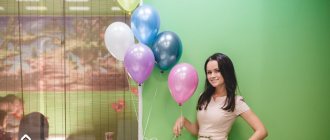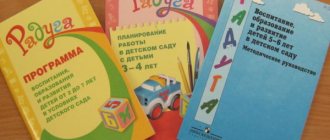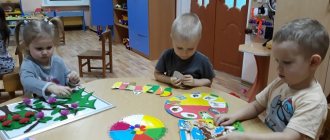Card index of educational design games.
Construction. Didactic games.
Let's build a house. (Jr., Middle Gr.)
Target:
Composition of houses of different sizes. Teach children to select doors, windows, roofs that correspond to the size of a given house.
Material:
Parts of houses of different sizes to make up 5 buildings of varying sizes.
Progress:
Sets of parts are laid out in disarray. The child selects the appropriate parts. The number of houses compiled depends on the child’s capabilities.
What is missing? (Jr., Middle Gr.)
Target:
To develop children's attention and observation skills. Develop logic and evidence-based speech.
Material:
Maps depicting various buildings that are missing any detail. Geometric shapes for “repairing” buildings.
Progress of the game:
The child is offered an image of an object or structure (house, car...) that is missing one or another detail. The child tries to guess what part is missing and explain why it is necessary. Then “repair” the item.
Collect and build. (Jr., Middle Gr.)
Target:
Strengthen children's ability to recognize and name geometric shapes (square, rectangle, triangle, circle, oval). Lay out various objects from geometric shapes.
Material:
a cube with geometric shapes glued on, geometric shapes cut out of cardboard; contour samples of buildings.
Progress:
Option 1.
The child throws the dice, names the figure he sees on the top face and takes the same cardboard one of any color. From the figures collected over several moves, the child creates any image.
Option 2.
The child chooses a shape by color. The form, in this case, can be any. For example: A green triangle appears on the top face of the cube. The child is asked to choose any green figure. A building is also made from the collected figures.
Which building collapsed? (Jr., Middle Gr.)
Target:
Development of attention; logical thinking. Ability to recognize and name geometric shapes.
Material:
Cards with buildings made up of geometric shapes (hill, house, gate, etc.); and the same geometric shapes, but placed in a chaotic order.
Progress of the game:
An adult shows the child a card with geometric shapes scattered across the field (the shapes are pasted on) and offers to find a card with a structure made from the same shapes. First, two cards with buildings are given to choose from, then, when the children begin to easily cope with the task, the number of cards increases.
Workshop of forms.
Target:
Strengthen children's knowledge of geometric shapes. Lay out geometric shapes and objects according to the conditions.
Material:
Counting sticks, geometric shapes.
Progress:
Option 1. (Jr., Wed. gr.)
Children are invited to lay out geometric shapes from sticks according to patterns. The samples are various rectangles, squares, triangles.
Option 2. (st.gr.)
Children are invited to lay out various objects from sticks according to the conditions. For example: a triangle of 3 sticks, 5, 6; rectangle of 6, 8; house of 6, 11, etc.
Do you have it or not?
Target:
Teach children to recognize familiar shaped objects by touch.
Material:
Two muffs; two sets of simple-shaped objects (ball, apple, pear, egg, lemon, pyramid, cube, brick, etc.); box.
Progress:
Option 1. (junior, middle group)
The teacher shows the children two muffs and demonstrates how to insert two hands into the muff and lets the children try for themselves how this is done.
Taking each toy out of the box in turn, the teacher shows it to the children and places it on the table. Children name objects and examine them from all sides. Then the teacher puts one set of toys in one muff, and the called child puts the second set in another.
V. – They hid from our toys. No problem, now we will look for them and find them.
The teacher calls two children over and seats them opposite each other at the table. Each child receives a muff with toys. Who will be the first to look for the toy is determined by a counting rhyme:
To have fun playing
We need to count everyone.
One two Three,
The first one is you.
Addressing the first child, the teacher invites him to choose what he likes in his muff. (Remind the child the technique of examining an object with his hands, feeling it from different sides).
V. – Did you choose? Then say what you found and ask if Pasha has the same toy. You need to say: “I have a ball. Do you have it or not?” - and place the named item on the table. The other partner must find the same object in his muff and answer: “And I have a ball,” then take it out of the muff and put it next to it for comparison.
The game continues, only now the second child chooses a toy, and the first finds the same one in his muff. Having assessed the correctness of the solution to the problem, the teacher selects two other children, and the game continues.
Option 2. (Wed, old class)
Construction parts are placed in the muff. It is necessary to name the part correctly.
Option 3. (st., preg. gr)
The first player does not name the part, but describes it. For example: “I have a part in which two sides are triangles and three sides are rectangles.” The second player names the part and looks for it in his muff. After this, both players take out the parts and check the correctness of the solution to the problem.
Where is your home?
Target:
Development of meaningful perception of the shape of geometric figures; recognizing the shape of a figure only with the help of a visual analyzer.
Material:
Small cards with images of geometric shapes: circle, square, oval, rectangle, triangle for each child; five large cards depicting the same figures.
Progress:
The teacher calls four children over and gives each of them a large card with the identification mark of the new house into which the residents will move. Children with cards take their places (stand in the drawn circles).
The remaining participants in the game receive small cards - this is an invitation to move to a new home.
V. – There is a figure drawn on the invitation that will help you find a new home. In order not to confuse your house with someone else’s, you need to carefully examine all the figures on the houses and choose the same one as on the card.
After this, the children move freely around the playground for some time. They don’t yet know where whose house is, because... They had not yet been shown large maps. At the teacher’s signal “Stop,” children with large cards (owners) will pick them up, and children pretending to be residents will have to stop, look at their cards, and then look for where the same figures are on the houses.
After a short pause, the teacher asks: “Where is your home?” After these words, the children run away to their homes. Once the house is completely occupied, all residents raise their cards. The teacher and the “owners” of the houses check in which house the residents gathered first and whether everyone has found their house correctly, notes the winners.
Then the adult collects small and large cards, selects new “hosts,” distributes new invitations, and the game is repeated.
Stroke.
Target:
Introduce children to the ability of geometric shapes to “transform” into various objects. Development of imagination. Dictionary development. Preparing your hand for writing.
Material:
Geometric figures. Colour pencils.
Progress:
The teacher tells the children some story or fairy tale (the topic is chosen by the teacher). Then the children are given a geometric figure (or several), asked to circle it and finish drawing it so that it turns out to be a hero of the story or an object.
Notes:
The game can be used by all age groups.
Architect.
Target:
Develop the ability to compose a serial series. Train your child in the ability to create a construction plan.
Material:
Stripes of different lengths (up to 10 gradations); a sheet of paper, a simple pencil.
Progress:
Option 1 .
(Med., Art. Gr.)
Arrange the strips in disarray. Invite the children to arrange them in order: from smallest to largest or from largest to smallest.
Option 2. (st., preg. gr.)
Arrange the strips in disarray. Invite the children to draw a plan for the staircase without touching the stripes. Then, offer to take the strips and build the stairs according to the plan.
Find out the subject.
Target:
Recognize a schematically depicted object. Build an item from builder parts; make up of geometric shapes.
Material:
Schematic images of various objects; geometric figures; construction details.
Progress:
Option 1. (cf. gr.)
Show the child a picture with a schematically depicted object. The child names the object, says what geometric shapes it can be made from, and constructs it.
Option 2. (st., preg. gr.)
The child recognizes a schematically depicted object and builds it from the builder’s parts, independently selecting the necessary parts.
Find out what has changed? (art., subg.gr.)
Target:
Exercise children in correctly determining the spatial arrangement of objects: right, left, in front, behind, on the side, near, etc. Develop observation skills and active memorization. Fix the name of geometric shapes or construction parts.
Material:
Geometric shapes or details of a wooden construction set; Parsley; screen.
Progress:
The children help Petrushka figure out where the objects are. Behind the screen, objects change places. Only those children whom Parsley points out name the change in the arrangement of objects.
Complication:
The number of parts increases; swaps the places of more than two objects.
What is this length? Width? Heights? (art., subg. gr.)
Target:
Teach children to pay attention not only to the overall size of an object, but also to its individual parameters - length, width, height.
Material:
Strips of different lengths.
Progress:
An adult thinks of some object (for example: a table) and makes a narrow paper strip equal to its length. To guess the mystery, the child will need to compare the length of different objects in the group with this strip. Then you can guess another object by measuring its height and the next one by measuring its width.
Hot - cold. (old age)
Target:
Reinforce in children the names of the parts of a wooden construction set. Develop coherent speech.
Material:
Designer details; matryoshka
Progress:
Examine the details with the children, place them so that they are clearly visible and so that they can be approached.
V. – today we will play the game “Hot - Cold”. Let's choose a driver. He will go out the door, and we will hide the nesting doll behind some detail. If he sees a nesting doll behind a part, he must name it, and only after that can it be taken. We will help the driver, if he has gone far away - we will say: “Cold”, if close - “Warm”, if very close - “Hot”.
The leader is chosen using a counting rhyme. The number of parts depends on the age and level of preparedness of the children.
Happy Island. (old age)
Target:
Development of imagination. Skill to work in team. Reinforcing the names of geometric shapes.
Material:
Multi-colored geometric shapes and their parts.
Progress:
The teacher determines the topic. Children create a building together. The construction must correspond to the nature of the theme.
Find the building according to the description.
Target:
Learn to find a building based on its description; develop observation skills; learn to describe a building without naming it; cultivate endurance.
Material:
Finished buildings (in the sub-group, you can use three-dimensional diagrams); Pinocchio toy.
Progress:
The teacher, together with Pinocchio and the children, examines the buildings. At the same time, the teacher pays attention to what parts the building consists of, how they are located relative to each other, what functional parts there are, and why this item is needed.
V. – Now Pinocchio and I will make a wish for one of the buildings, and Pinocchio will tell you about it. The one whom Pinocchio points to will name the hidden building. Pinocchio describes the building - the children guess.
Option.
The child describes the building. Pinocchio guesses. The game continues until all buildings have been guessed. Then Pinocchio offers the children small toys to play with the buildings.
Different houses. (old age)
Target:
Teach children to compare a drawing and a drawing (diagram) of an object.
Material:
Cards with outline images of buildings of complex shape (houses with different roofs, extensions). Children are offered 4 schemes. Three detailed pictures for each diagram. In each picture there is a slight discrepancy with the diagram: the difference is in the shape of the roof of one of the extensions, in the location of the extensions, in their height, etc.
Progress:
An adult tells the children that once the builders were building a house according to the drawing and made small mistakes. And although the houses turned out beautiful, they were still a little different from the drawing. Offers to examine each building and find inaccuracies. The teacher shows the children the first diagram and a picture for it. Children find a mistake. Then the teacher shows the next picture for the same diagram, then the third. Next, they move on to the second scheme and examine three more pictures in succession. If the children cannot find the correct answer, the teacher helps them. The rest of the drawings and drawings are treated in the same way.
In this game you can use a variety of drawings and designs.
Guess what. (old age)
Target:
Teaching children to adhere to a certain plan when analyzing a subject, i.e. sequentially asking a series of questions, first of a general nature - about the purpose of the object, its appearance as a whole, and more specific ones - about the parts of the object, their features and structure.
Material:
A set of drawings depicting various objects and buildings (a hut on chicken legs, an airplane, a swing, an ice palace, a bridge, etc.)
Progress:
The pictures are placed in front of the children. An adult invites the children to play the game “Guess.” He will guess the object that the children themselves will choose from several shown in the pictures. The adult asks questions, and the children answer only “yes” or “no.” Questions might be something like: “Is this a common item? - No. Is this a fairy tale item? - Yes. Is it used for transportation? - No. Do they live in it? - Yes. Is it on chicken legs? - Yes. Is this Baba Yaga's hut? - Yes".




